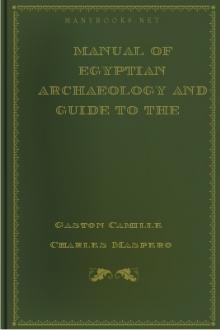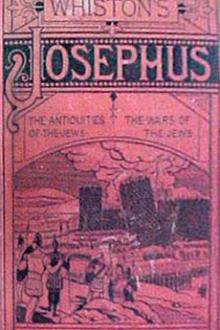Manual of Egyptian Archaeology and Guide to the Study of Antiquities in Egypt by Gaston Maspero (i have read the book txt) 📕

107. Wall-scene from temple of Denderah
108. Obelisk of Heliopolis, Twelfth Dynasty
109. Obelisk of Begig, Twelfth Dynasty
110. "Table of offerings" from Karnak
111. Limestone altar from Menshîyeh
112. Wooden naos, in Turin Museum
113. A mastaba
114. False door in mastaba
115. Plan of forecourt, mastaba of Kaäpir
116. Plan of forecourt, mastaba of Neferhotep
117. Door in mastaba façade
118. Portico and door of mastaba
119. Plan of chapel, mastaba of Khabiûsokari
120. Plan of chapel, mastaba of Ti
121. Plan of chapel, mastaba of Shepsesptah
122. Plan of chapel, mastaba of Affi
123. Plan of chapel, mastaba of Thenti
124. Plan of chapel, mastaba of Red Scribe
125. Plan of chapel, mastaba of Ptahhotep
126. Stela in mastaba of Merrûka
127. Wall-scene from mastaba of Ptahhotep
128. Wall-scene from mastaba of Ûrkhûû
129. Wall-scene from mastaba of Ptahhotep
130. Plan of serdab in mastaba at Gizeh
131. Plan of serdab and
Read free book «Manual of Egyptian Archaeology and Guide to the Study of Antiquities in Egypt by Gaston Maspero (i have read the book txt) 📕» - read online or download for free at americanlibrarybooks.com
- Author: Gaston Maspero
- Performer: -
Read book online «Manual of Egyptian Archaeology and Guide to the Study of Antiquities in Egypt by Gaston Maspero (i have read the book txt) 📕». Author - Gaston Maspero
But it is in the carving of perfume-spoons and kohl-bottles that the inventive skill of the craftsman is most brilliantly displayed.
Not to soil their fingers the Egyptians made use of spoons for essences, pomades, and the variously-coloured preparations with which both men and women stained their cheeks, lips, eyelids, nails, and palms. Fig 247.--Spoon. Fig 247.--Spoon.
The designer generally borrowed his subjects from the fauna or flora of the Nile valley. A little case at Gizeh is carved in the shape of a couchant calf, the body being hollowed out, and the head and back forming a removable lid. Fig 248.--Spoon. Fig 248.--Spoon.
A spoon in the same collection represents a dog running away with an enormous fish in his mouth (fig. 246), the body of the fish forming the bowl of the spoon. Another shows a cartouche springing from a full-blown lotus; another, a lotus fruit laid upon a bouquet of flowers (fig. 247); and here is a simple triangular bowl, the handle decorated with a stem and two buds (fig. 248). The most elaborate specimens combine these subjects with the human figure. A young girl, clad in a mere girdle, is represented in the act of swimming (fig. 249). Her head is well lifted above the water, and her outstretched arms support a duck, the body of which is hollowed out, while the wings, being movable, serve as a cover. We have also a young girl in the Louvre collection, but she stands in a maze of lotus plants (fig. 250), and is in the act of gathering a bud. A bunch of stems, from which emerge two full-blown blossoms, unites the handle to the bowl of the spoon, which is in reverse position, the larger end being turned outwards and the point inwards.
Fig 249.--Spoon. Fig 249.--Spoon.
Elsewhere, a young girl (fig. 251) playing upon a long-necked lute as she trips along, is framed in by two flowering stems. Fig 250.--Spoon. Fig 250.--Spoon.
Sometimes the fair musician is standing upright in a tiny skiff (fig. 252); and sometimes a girl bearing offerings is substituted for the lute player. Fig 251. --Spoon. Fig 251. --Spoon.
Another example represents a slave toiling under the weight of an enormous sack. The age and physiognomy of each of these personages is clearly indicated. The lotus gatherer is of good birth, as may be seen by her carefully plaited hair and tunic. The Theban ladies wore long robes; but this damsel has gathered up her skirts that she may thread her way among the reeds without wetting her garments. The two musicians and the swimming girl belong, on the contrary, to an inferior, or servile, class. Two of them wear only a girdle, and the third has a short garment negligently fastened. The bearer of offerings (fig. 253) wears the long pendent tresses distinctive of childhood, and is one of those slender, growing girls of the fellahîn class whom one sees in such numbers on the banks of the Nile. Fig 253.--Spoon. Fig 253.--Spoon.
Her lack of clothing is, however, no evidence of want of birth, for not even the children of nobility were wont to put on the garments of their sex before the period of adolescence. Fig 252.--Spoon. Fig 252.--Spoon.
Lastly, the slave (fig. 254), with his thick lips, his high shoulders, his flat nose, his heavy, animal jaw, his low brow, and his bare, conical head, is evidently a caricature of some foreign prisoner. The dogged sullenness with which he trudges under his burden is admirably caught, while the angularities of the body, the type of the head, and the general arrangement of the parts, remind one of the terra-cotta grotesques of Asia Minor. In these subjects, all the minor details, the fruits, the flowers, the various kinds of birds, are rendered with much truth and cleverness. Of the three ducks which are tied by the feet and slung over the arms of the girl bearing offerings, two are resigned to their fate, and hang swinging with open eyes and outstretched necks; but the third flaps her wings and lifts her head protestingly. The two small water-fowl perched upon the lotus flowers listen placidly to the lute-player's music, their beaks resting on their crops. Fig 254.--Spoon. Fig 254.--Spoon.
They have learned by experience not to put themselves out of the way for a song, and they know that there is nothing to fear from a young girl, unless she is armed. They are put to flight in the bas-reliefs by the mere sight of a bow and arrows, just as a company of rooks is put to flight nowadays by the sight of a gun. The Egyptians were especially familiar with the ways of animals and birds, and reproduced them with marvellous exactness. The habit of minutely observing minor facts became instinctive, and it informed their most trifling works with that air of reality which strikes us so forcibly at the present day.
Household furniture was no more abundant in ancient Egypt than it is in the Egypt of to-day. In the time of the Twelfth Dynasty an ordinary house contained no bedsteads, but low frameworks like the Nubian angareb; or mats rolled up by day on which the owners lay down at night in their clothes, pillowing their heads on earthenware, stone, or wooden head-rests. Fig 255.--Fire-sticks, bow, and unfinished drill-stock, Twelfth Dynasty; Illahûn, Kahun, and Gurob, W.M.F. Petrie, Plate VII., p. 11. Fig 255.--Fire-sticks, bow, and unfinished drill-stock, Twelfth Dynasty; Illahûn, Kahun, and Gurob, W.M.F. Petrie, Plate VII., p. 11.
There were also two or three simple stone seats, some wooden chairs or stools with carved legs, chests and boxes of various sizes for clothes and tools, and a few common vessels of pottery or bronze. For making fire there were fire- sticks, and the bow-drill for using them (figs. 255 and 181); children's toys were even then found in great variety though of somewhat quaint construction. Fig 256.--Remains of two Twelfth Dynasty dolls; Kahun, Gurob and Hawara, W.M.F. Petrie, Plate VIII. p. 30. Fig 256.--Remains of two Twelfth Dynasty dolls; Kahun, Gurob and Hawara, W.M.F. Petrie, Plate VIII. p. 30.
There were dolls with wigs and movable limbs, made in stone, pottery, and wood (fig. 256); figures of men, and animals, and terra-cotta boats, balls of wood and stuffed leather, whip-tops, and tip-cats (fig. 257).
The art of the cabinet-maker was nevertheless carried to a high degree of perfection, from the time of the ancient dynasties. Planks were dressed down with the adze, mortised, glued, joined together by means of pegs cut in hard wood, or acacia thorns (never by metal nails), polished, and finally covered with paintings.
Fig 257.--Tops, tip-cat, and a terra-cotta toy boat, Twelfth Dynasty; Kahun, Gurob, and Hawara, W.M.F. Petrie, Plates VIII., IX., p. 30. Fig 257.--Tops, tip-cat, and a terra-cotta toy boat, Twelfth Dynasty; Kahun, Gurob, and Hawara, W.M.F. Petrie, Plates VIII., IX., p. 30.
Chests generally stand upon four straight legs, and are occasionally thus raised to some height from the ground. Fig 258.--Chest Fig 258.--Chest
The lid is flat, or rounded according to a special curvature (fig. 258) much in favour among the Egyptians of all periods. Sometimes, though rarely, it is gable-shaped, like our house-roofs (fig. 259). Fig 259.--Chest Fig 259.--Chest
Generally speaking, the lid lifts off bodily; but it often turns upon a peg inserted in one of the uprights. Sometimes, also, it turns upon wooden pivots (fig. 260). The panels, which are large and admirably suited for decorative art, are enriched with paintings, or inlaid with ivory, silver, precious woods, or enamelled plaques. It may be that we are scarcely in a position justly to appraise the skill of Egyptian cabinet-makers, or the variety of designs produced at various periods. Fig 260.--Chest Fig 260.--Chest
Nearly all the furniture which has come down to our day has been found in tombs, and, being destined for burial in the sepulchre, may either be of a character exclusively destined for the use of the mummy, or possibly a cheap imitation of a more precious class of goods.
The mummy was, in fact, the cabinet-maker's best customer. In other lands, man took but a few objects with him into the next world; but the defunct Egyptian required nothing short of a complete outfit. The mummy- case alone was an actual monument, in the construction of which a whole squad of workmen was employed (fig. 261).
Fig 261.--Construction of a mummy-case, wall scene, Eighteenth Dynasty. Fig 261.--Construction of a mummy-case, wall scene, Eighteenth Dynasty.
The styles of mummy-cases varied from period to period. Under the Memphite and first Theban empires, we find only rectangular chests in sycamore wood, flat at top and bottom, and made of many pieces joined together by wooden pins. The pattern is not elegant, but the decoration is very curious. The lid has no cornice. Outside, it is inscribed down the middle with a long column of hieroglyphs, sometimes merely written in ink, sometimes laid on in colour, sometimes carved in hollowed-out signs filled in with some kind of bluish paste. The inscription records only the name and titles of the deceased, accompanied now and then by a short form of prayer in his favour. The inside is covered with a thick coat of stucco or whitewash.
Upon this surface, the seventeenth chapter of The Book of the Dead was generally written in red and black inks, and in fine cursive hieroglyphs. The body of the chest is made with three horizontal planks for the bottom, and eight vertical planks, placed two and two, for the four sides. The outside is sometimes decorated with long strips of various colours ending in interlaced lotus-leaves, such as are seen on stone sarcophagi. More frequently, it is ornamented on the left side with two wide-open eyes and two monumental doors, and on the right with three doors exactly like those seen in contemporary catacombs. The sarcophagus is in truth the house of the deceased; and, being his house, its four walls were bound to contain an epitome of the prayers and tableaux which covered the walls of his tomb. The necessary formulae and pictured scenes were, therefore, reproduced inside, nearly in the same order in which they appear in the mastabas. Each side is divided in three registers, each register containing a dedication in the name of the deceased, or representations





Comments (0)